|
| Page: [Previous] [Next] 1 2 |
| (1) Posted by Sarah Hornecker [Wednesday, Mar 28, 2007 05:37]; edited by Sarah Hornecker [07-03-28] |
Hybrids (Study = Helpmate, Directmate = Selfmate, etc.)
What about a helpmate, that also could be a directmate? Have there ever been composed such examples?
Maybe this:
a) mate in 2
b) selfmate in 2
Sometimes I think the same position is used by two different composers with two different stipulations (especially with less than 7 pieces). I think, some studies could also be used as helpmate etc.
A (bad) example:
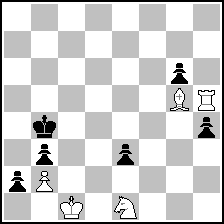 (= 5+6 ) (= 5+6 )
Siegfried Hornecker
Study: Problem-Forum, March 2005; White wins
h#2: Original
This study (1. Be7+ Ka4 2. Sc2!! bxc2 3. b3+! Kxb3 4. Ra5 h3 5. Ra3+ Kc4 6. Rxa2 e2 7. Rxc2+ Kd3 8. Bb4 h2 9. Rc3+ Ke4 [9. ... e1Q+???] 10. Rh3 wins) also contains a h#2, although with a very bad solution (1. e2 Bd2+ 2. Ka4 Ra5#).
Another example:
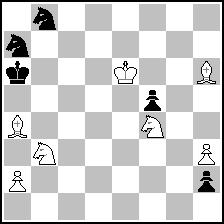 (= 7+5 ) (= 7+5 )
Siegfried Hornecker
Study: Magyar Sakkvilag, October 2006
h#2: Original, 2 solutions
Study: 1. Sc5+ Kb6 2. Sd5+ Kxc5 3. Be3+ Kc4 4. Bd1 h1Q 5. Be2#
h#2: 1. Sbc6 Sd5 2. Sa5 Sc5# (repetition of the study's moves of white) and 1. Sd7 Sd3 2. Sb5 Sdc5# (other knight mates on the same field)
Of course, the helpmate is still bad, but some (half-)thematical content could be interpreted into it if one wants... IMO the second solution is like a dual here.
What do you think about such hybrids? I remember I've seen something like it before (I think with directmate and selfmate, from Samuel Loyd).
What about the authorship in such a case? Should the author be the author of the diagram or the one who discovers another content there?
Best regards,
Siegfried Hornecker
|
|
| (2) Posted by Frank Richter [Wednesday, Mar 28, 2007 08:07] |
Some yeras ago there was a whole tourney for such hybrids (Jarolin-50):
Here is the award:
http://www.rubriky.net/sutaz/oddelenie.htm
It is especially interesting, that my primary first prize (I found a s#2 in a #2 with reciprocal change) was disqualified by reason of an predecessor !
|
|
| (3) Posted by Sarah Hornecker [Wednesday, Mar 28, 2007 14:53]; edited by Sarah Hornecker [07-03-28] |
Hi!
Many thanks, that's what I'm looking for!
Especially this one is impressive since it has a #3 and h#3.
http://www.rubriky.net/sutaz/ba28.php
Your (anticipated) problem is here: http://www.rubriky.net/sutaz/ba22.php
If anyone knows more such problems, please post!
|
|
| (4) Posted by Hauke Reddmann [Monday, Apr 2, 2007 19:28] |
See another thread on this board. Darn, which one? :-)
(I refer to the #/=/s#/s= duplex by me from feenschach. It's on my
webpage too, of course...now where was the thread..."Duals" in Selfmate
or the like.)
Hauke
|
|
| (5) Posted by Administrator [Monday, Apr 2, 2007 19:51] |
QUOTE
Hauke: ... now where was the thread..."Duals" in Selfmate or the like
See Mat Plus Review pages 22-25 - it's not always bad to have it printed :-))
|
|
| (6) Posted by Frank Richter [Tuesday, Apr 17, 2007 08:16] |
@Siegfried Hornecker:
Just now another competition for "hybrids" is finished:
http://www.selivanov.ru/download/Awards/Drugie/2007/Redkie.doc
|
|
| (7) Posted by Yochanan Afek [Friday, Apr 20, 2007 17:00]; edited by Yochanan Afek [07-04-20] |
Dear Siegfried,
Just for the sake of variety,I can recall a tourney run in Pula PCCC congress 2000 requiring 2 types in the same position but with reversed colours:
Yochanan Afek
3rd Prize, Pula 2000
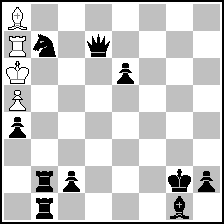 (= 4+10 ) (= 4+10 )
a)H#2 1211
1.Kh1 Bxb7 + 2.Qc6+ Bxc6#
1...Rxb7 2.Qb5+ Rxb5#
b)All pieces change colour- S2#
1.Kh1! (waiting) Bxb7+ / Rxb7 2.Qc6+
/2.Qb5+
I believe readers have the complete award if needed.
|
|
| (8) Posted by Ion Murarasu [Friday, Apr 20, 2007 19:29] |
Here is a special "hybrid" with 4 stipulation:
Ion MURARASU
harmonie 1999
 (= 6+5 ) (= 6+5 )
a)#2
b)=2
c)s#2
d)h#2
Solutions:
a) 1.S×e2! g3 2.Sf4#
b)1.R×e2! blocus
1…g3 2.Rg2=
1…Kg3 2.R×h2=
c) 1.Sef5! g3 2.Sh6 g2#
d) 1.Kg3 Bf4+ 2.Kf2 R×e2#
|
|
| (9) Posted by Ion Murarasu [Friday, Apr 20, 2007 21:26] |
And a fairy hybrid ...a first prize of my friend Paul
Paul RAICAN
StrateGems 2005 1st Prize
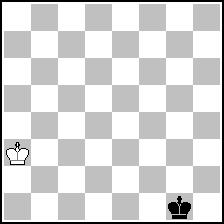 (= 1+1+2N ) (= 1+1+2N )
Circe Maximum
a) #6
b) S#6
Solutions:
a) 1.h8=Qn! Qna8+ 2.Kb3 Qnf3+ 3.Qnf2+ Qnf8 4.g8=Rn+ Kh2 5.Qnç5 Rng1 6.Qn×g1(Rnh8)#
b) 1.h8=Rn! Rna8+ 2.Kb2 Rnh8 3.Kç1 Rna8 4.g8=Qn+ Qna2 5.Rn×a2(Qnd8) Rnh2 6.Rnd2 Qn×d2(Rna1)#
|
|
| (10) Posted by Thomas Maeder [Friday, Apr 20, 2007 22:26] |
The most famous hybrid problem is, obviously, the most famous problem ever composed (admittedly in a different setting), as Fadil Abdurahmanović and I independently found out almost 10 years ago:
Henry A. Loveday
The Chess Player's Chronicle 1845
(V. Johann Berger
Akademische Monatshefte für Schach 1927)
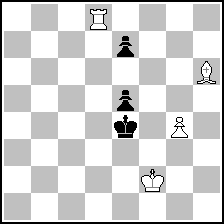 (= 4+3 ) (= 4+3 )
Same solution as #3 and h#2.5, which I don't think I have to give ...
|
|
| (11) Posted by David Knezevic [Saturday, Apr 21, 2007 01:24] |
Thanks Thomas for the smile you put on my face :)
Being a curious person, I wondered if it was possible to make a conventional h#3 from this, and, beleive it or not, the first change I made to the position resulted with:
 (= 4+4 ) (= 4+4 )
h#3*
Not a miniature, though, but I was stunned anyway! Anticipated??
|
|
| (12) Posted by Uri Avner [Saturday, Apr 21, 2007 02:32]; edited by Uri Avner [07-04-21] |
Splendid, Milan! May well be a novelty.
[Some hours of sleep later]
Toying further with your idea shows the possibility of 2 solutions:
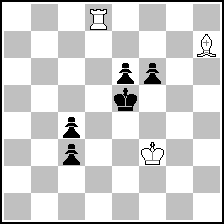 (= 3+5 ) (= 3+5 )
H#3
2 solutions
1.f5 Rf8 2.Kd4 Rxf5 3.Kd3 Rd5#
1.c2 Bxc2 2.c3 Rd3 3.Kf5 Rd5#
I like more your set & sol version; this one is just for the record.
|
|
| (13) Posted by Thomas Maeder [Saturday, Apr 21, 2007 11:25]; edited by Thomas Maeder [07-04-21] |
You are welcome, Milan.
I wonder what your motivation is for adding another rather uninteresting half move; in my opinion, h#2.5 is exactly the appropriate length for this problem.
[Minutes later]
Oh, now I see. There is an asterisk indicating a set play! Nice indeed!
|
|
| (14) Posted by David Knezevic [Saturday, Apr 21, 2007 13:39] |
I saw that, Uri, but for me also the set play is much superior. In fact, for me a real helpmate must have a set play, and possibly a try. The only drawback is that in "my" position black has only one possible move. Perhaps the following is better:
 (= 4+4 ) (= 4+4 )
h#3*
The set play is also more beautiful here.
Since we are invading the "hybruds" thread perhaps the stipulation:
A) h#3
B) h#2.5
would be more appropriate :)
|
|
| (15) Posted by Uri Avner [Saturday, Apr 21, 2007 14:37]; edited by Uri Avner [07-04-21] |
Milan, for me the Loveday connection, which is at least psychologically broken in your last version, is all important (compare my view of Sally and Tony's "embodied Loyd" problem). I would therefore definitely prefer your original version. The possibility of bxc2 is highly artificial anyway, and the final mate on the same square has merits of its own, keeping a sort of unity within the variety of coming from two different directions of the B/R battery.
|
|
| (16) Posted by Marek Kwiatkowski [Saturday, Apr 21, 2007 16:02]; edited by Marek Kwiatkowski [07-04-21] |
It seems to me that, in helpmates, the black side should help to get a mate.
example
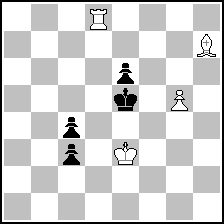 (= 4+4 ) (= 4+4 )
#4
Uri, your version, in my opinion, is better.
|
|
| (17) Posted by Hannu Harkola [Saturday, Apr 21, 2007 18:41] |
As early as 1966 there was an international Osmo Kaila 50 JT from this idea. I don't have the results just now.
In 1992-94 was Osmo Kaila MT in two sections, a) orthodox and b) others. There were 58+49 entries. In section a the prizes went to A. Kuzovkov (2# & h#2 with pickaninnys), U. Heinonen (h#4 & h=4), P. Gvozdjak (2# & s#2). The winner in section b was A. Vasilenko (2#, s#2, h#2, h=2* with grasshoppers and nightrider).
|
|
| (18) Posted by Michael McDowell [Saturday, Apr 21, 2007 21:18] |
Problems with multiple stipulations seem to have been common in the 19th century. Volume 1 of Brentano’s Chess Monthly from 1881-2 contains at least five examples. They were not intended to be serious problems and were often used to mark a chess occasion or as a tribute to someone. Here’s one example:
J.N.Babson
Brentano’s Chess Monthly, January 1882
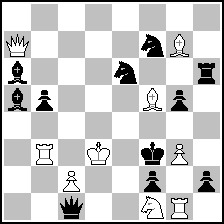 (= 9+11 ) (= 9+11 )
White or Black to mate or selfmate in 2
Keys: 1.Qa8+, 1.Qd1+, 1.Sxh2+, 1.b4+
Guess who the problem was dedicated to….
The big difficulty of course is composing something with interesting content. Peter Gvozdják and Emil Klemanic have produced mate/stalemate examples with cyclic play. A four-fold example:
Emil Klemanic, 3rd Prize, Nedelná Pravda 1993
 (= 11+5 ) (= 11+5 )
a) Mate in 2 b) Stalemate in 2
a) 1.Kf7
1…Kd5 2.Qxc6
1…Kd3 2.Sc5
1…Kf5 2.Bxg6
1…Kxf3 2.Sg5
b) 1.Bxe5
1…Kd5 2.Seg5
1…Kd3 2.Qxc6
1…Kf5 2.Sc5
1…Kxf3 2.Bxg6
|
|
| (19) Posted by Guy Sobrecases [Sunday, Apr 29, 2007 02:09] |
Milan,
Your nice h#3* looks new, according to Winchloé. I did not find any similar example.
|
|
| (20) Posted by Guy Sobrecases [Sunday, Apr 29, 2007 02:18] |
Guy SOBRECASES
Peter HARRIS
The Problemist Supplement 2007
 (= 3+5 ) (= 3+5 )
Madrasi
a)h‡2
b)h=2
a)
1.Bh4 g4 2.Kh5+ K×f5‡
b)
1.Kh5+ K×f5 2.Bh4 g4=
|
|
Read more... |
Page: [Previous] [Next] 1 2
MatPlus.Net  Forum Forum  General General  Hybrids (Study = Helpmate, Directmate = Selfmate, etc.) Hybrids (Study = Helpmate, Directmate = Selfmate, etc.) |
 ISC 2024
ISC 2024 Forum
Forum  General
General  Hybrids (Study = Helpmate, Directmate = Selfmate, etc.)
Hybrids (Study = Helpmate, Directmate = Selfmate, etc.) 


